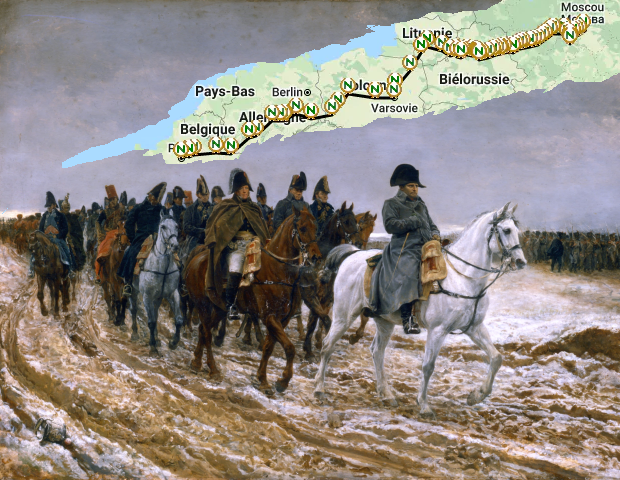Where was Napoléon that day?
- Per day
- By location
- Nearest location
To find the closest Napoleonic stage to a given point, you must:
- Either enter the coordinates of this point then click on the button "See the nearest Napoleonic place"
- Either click on the map
- Either click on the "Use my location" button (visible if you have activated geolocation)
Then click on the N surrounded by a laurel wreath which will have appeared on the map to find out the dates of Napoléon's visit to this place.
During his life, Napoleon traveled around one hundred and twenty thousand kilometers, one hundred thousand if we eliminate the maritime journeys. At a time when stages of one hundred and fifty kilometers constituted a memorable feat, this is a record that none of his contemporaries can be proud of. By June 20, 1815, his steps took him from Astorga [42.45461,-6.05310] in the west to Moscow [55.75083,37.61722] in the east and from Petrovskoye Castle [55.79366,37.55260] in the north to the Fountains of Moses [29.86495,32.65578] to the south. Shortly after, the British cautery will introduce him to the waters, the skies and a tiny parcel of land in the southern hemisphere before narrowly limiting his horizons. How can we be surprised that such a man would have been bored to death on an island measuring fifteen by ten kilometers, even if his movements there had not been, as they were, hampered and monitored with the strictest pettiness?
From his early youth, Napoleon left his native Corsica then crossed half of France to join his school in Autun (six hundred and fifty kilometers as the crow flies, more than eight hundred by sea then by road). A few months later, he moved further away from his roots, settling in Brienne, one hundred and fifty kilometers further north. Five more years and it was Paris that welcomed him, ever further from the family home. Also, as soon as he had the means and the possibility, he began to multiply the trips to his beloved island: no less than five in seven years (remember that such a journey then requires around fifteen days in each direction). On site, he maked multiple trips between Ajaccio, Bastia or Corte. But these journeys will soon be nothing more than quick leaps for him. Three years after the last one, he put on the giant boots with which he will now explore not only Europe, but also Africa and Asia.
Of the five continents listed at that time, only America and Australia remained unknown to him. However, he initially wanted to settle in the New World when his defeat at Waterloo chased him from the old world. Would he have lived there, like his brother Joseph, as a peaceful gentleman farmer? Impossible to know, unless we believe, as told by certain legends or the short story by Stephen Crane which inspired the film "Monsieur N", that he escaped from Saint Helena to settle in some rural town where he was never heard of again.
According to our calculations, between June 11, 1794 and June 19, 1815, Napoleon spent 2681 days out of 7647 abroad, or 35.5% of his time. And most of these days were spent moving from one point to another with this energy which amazed his contemporaries and which we admire so much. Yet his stays in France were not limited to a comfortable rest in Saint-Cloud, Malmaison or the Tuileries. He could sometimes travel through it at a reasonable tempo, as during his honeymoon in the company of Empress Marie-Louise in 1810. But he could also cross it at a lightning pace, as when he returned from Spain in 1809 , traveling the seven hundred kilometers from Bayonne to Paris in five days.
These are the movements that you will be able to examine on this page, either by tracking the Emperor from one day to the next, or by examining the dates of his visits to this or that locality, or even by discovering, for a given place, the closest crossing point to Napoleon.
